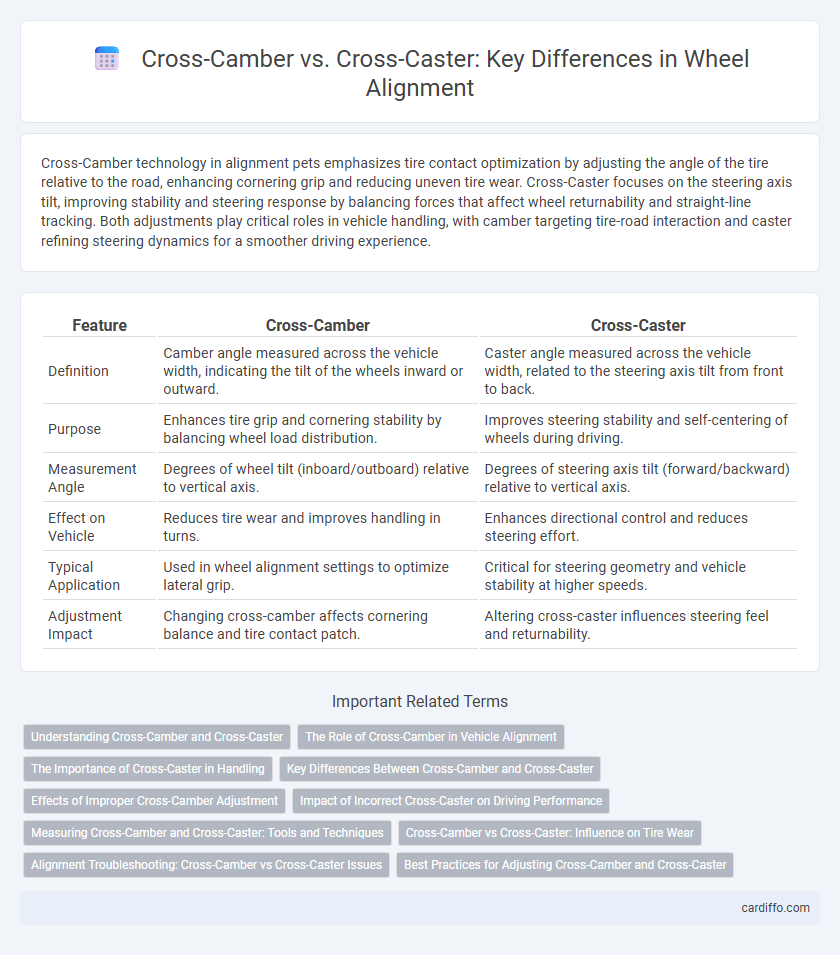Cross-Camber technology in alignment pets emphasizes tire contact optimization by adjusting the angle of the tire relative to the road, enhancing cornering grip and reducing uneven tire wear. Cross-Caster focuses on the steering axis tilt, improving stability and steering response by balancing forces that affect wheel returnability and straight-line tracking. Both adjustments play critical roles in vehicle handling, with camber targeting tire-road interaction and caster refining steering dynamics for a smoother driving experience.
Table of Comparison
| Feature | Cross-Camber | Cross-Caster |
|---|---|---|
| Definition | Camber angle measured across the vehicle width, indicating the tilt of the wheels inward or outward. | Caster angle measured across the vehicle width, related to the steering axis tilt from front to back. |
| Purpose | Enhances tire grip and cornering stability by balancing wheel load distribution. | Improves steering stability and self-centering of wheels during driving. |
| Measurement Angle | Degrees of wheel tilt (inboard/outboard) relative to vertical axis. | Degrees of steering axis tilt (forward/backward) relative to vertical axis. |
| Effect on Vehicle | Reduces tire wear and improves handling in turns. | Enhances directional control and reduces steering effort. |
| Typical Application | Used in wheel alignment settings to optimize lateral grip. | Critical for steering geometry and vehicle stability at higher speeds. |
| Adjustment Impact | Changing cross-camber affects cornering balance and tire contact patch. | Altering cross-caster influences steering feel and returnability. |
Understanding Cross-Camber and Cross-Caster
Cross-camber refers to the angle of the wheel relative to the road surface when viewed from the front, affecting tire contact and cornering grip, while cross-caster measures the difference in caster angles between the left and right wheels, influencing steering stability and returnability. Understanding cross-camber involves analyzing wheel tilt to optimize traction and reduce uneven tire wear, whereas grasping cross-caster focuses on balancing steering effort and vehicle straight-line tracking. Proper adjustment of both cross-camber and cross-caster enhances overall vehicle handling, safety, and tire longevity.
The Role of Cross-Camber in Vehicle Alignment
Cross-camber plays a crucial role in vehicle alignment by balancing tire contact patches and enhancing cornering stability, particularly during dynamic driving conditions. Unlike cross-caster, which affects steering effort and returnability, cross-camber directly influences lateral tire wear and handling precision by managing the camber angles between the left and right wheels. Proper adjustment of cross-camber ensures optimal tire grip and even wear, improving overall vehicle performance and safety.
The Importance of Cross-Caster in Handling
Cross-caster plays a crucial role in vehicle handling by improving stability during cornering and reducing steering effort. Unlike cross-camber, which primarily affects tire wear and alignment, cross-caster directly influences the self-centering of the steering system and directional control. Properly adjusted cross-caster enhances road grip and driver confidence, especially in high-speed maneuvers and uneven road conditions.
Key Differences Between Cross-Camber and Cross-Caster
Cross-camber refers to the slight outward tilt of a wheel relative to the vertical axis, improving cornering stability and distributing tire wear evenly during lateral forces. Cross-caster involves the angled positioning of the steering axis, influencing steering stability and wheel returnability by controlling the self-centering effect. While cross-camber primarily affects tire contact and grip during turns, cross-caster impacts steering feedback and control, making these alignment settings essential for optimized vehicle handling and safety.
Effects of Improper Cross-Camber Adjustment
Improper cross-camber adjustment causes uneven tire wear, leading to reduced traction and handling instability, especially during cornering. Excessive positive or negative cross-camber results in increased tire scrub and compromised steering response, affecting vehicle safety and performance. Misalignment also accelerates suspension component stress, causing premature wear and potential failure.
Impact of Incorrect Cross-Caster on Driving Performance
Incorrect cross-caster alignment significantly disrupts steering stability, causing uneven tire wear and compromised handling precision. It leads to pulling sensations during acceleration and braking, reducing overall vehicle control and increasing driver fatigue. Precise cross-caster adjustment is essential for optimal cornering response and safety in dynamic driving conditions.
Measuring Cross-Camber and Cross-Caster: Tools and Techniques
Measuring cross-camber and cross-caster requires precision tools such as digital inclinometers and alignment gauges to ensure accurate readings of wheel angles relative to the vertical and longitudinal axes. Techniques involve positioning these instruments on the wheel hub or suspension components to capture the degree of inward or outward tilt for camber, and the backward or forward lean for caster. Advanced tools like 3D wheel alignment systems use laser sensors and cameras for real-time, high-accuracy assessment of both cross-camber and cross-caster angles during vehicle setup.
Cross-Camber vs Cross-Caster: Influence on Tire Wear
Cross camber affects tire wear by causing uneven pressure distribution across the tire's contact patch, leading to accelerated wear on the inner or outer edges. Cross caster influences tire wear differently by impacting steering stability and cornering forces, which can create irregular wear patterns due to inconsistent tire-road interaction. Understanding the distinct effects of cross camber and cross caster is crucial for optimizing alignment settings and extending tire life.
Alignment Troubleshooting: Cross-Camber vs Cross-Caster Issues
Cross-camber issues cause uneven tire wear on opposite edges, leading to pulling or drifting as the vehicle steers. Cross-caster problems result in inconsistent steering returnability and instability during cornering due to mismatched caster angles. Proper alignment diagnostics must distinguish between camber and caster discrepancies to ensure precise and safe vehicle handling.
Best Practices for Adjusting Cross-Camber and Cross-Caster
Adjusting cross-camber involves fine-tuning the tilt of the wheels relative to the road surface to improve tire contact and handling, with a recommended tolerance of +-0.5 degrees to avoid uneven tire wear. Cross-caster adjustments focus on aligning the steering axis for optimal stability and cornering response, typically maintained within a range of +-1 degree. Best practices emphasize using precise alignment tools and performing incremental adjustments to achieve manufacturer-specified angles that balance performance, safety, and tire longevity.
Cross-Camber vs Cross-Caster Infographic

 cardiffo.com
cardiffo.com